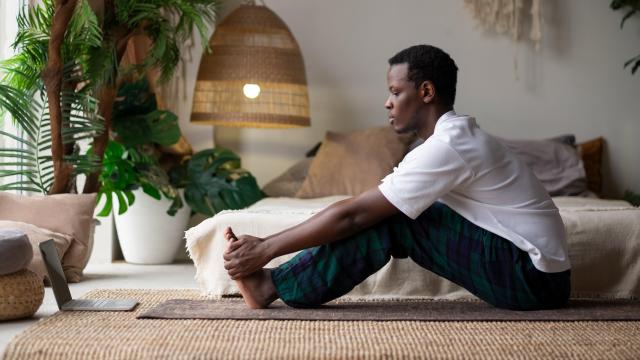In March, I’ve tried to figure out whether I could fit stretching into my fitness regimen and like doing it. After almost three weeks, I’m still doing pretty much the same routine I described in my last post. My biggest focus in this time has been consistency — I knew my biggest challenge would be actually doing the stretching session (which takes about 15 minutes), since I find stretching boring and will find any excuse not to do it. But I learned a few things that helped me keep to a routine.
Find a time of day when you can relax
At first, I had a good thing going: every evening, I would head to my (home) office, where my exercise bike lives. I would ride the bike, then do my stretching. This worked pretty well the first week: I usually did a 15-minute session on the bike (more if I had time), or five minutes as a warmup and then some kettlebell snatches. By the time I got to my stretching routine, I was already warm and ready to go.
Putting the stretching session last was a great way to allow myself to relax and take my time with it. I didn’t need to hurry up and get to work, or hurry up and get home to the kids. If I wanted to hang out a little longer in one stretch or another, I could do that. Sometimes I would put on music. And this is not a fitness hack, but: sitting for a long time in a stretch is actually kind of enjoyable when you’re high. Try it sometime.
Set a timer
According to the instructions on the program I started with, you’re supposed to do some small gentle bumping movements, then stretch for 10 seconds, then repeat the process for 20 and 30 seconds. I found this plan nearly impossible to follow. If I’ve been stretching for 10 seconds, I want a break, not a deeper stretch — and for some reason the stretches feel more difficult the longer I spend in them.
I think I know why: I was expecting to “relax into” each stretch, but if you relax, you’re no longer actively pulling yourself into the stretch. Contracting one muscle tends to help its antagonist (opposite muscle) relax, so passively forcing yourself into a position isn’t necessarily the best way to stretch.
The compromise I settled on: I start a stopwatch at the beginning of each stretching session and put the screen where I can see it. (I use online-stopwatch.com; a clock with a second hand would work just as well.) When I start a stretch, I look at the timer, and dedicate a full minute or more to that stretch. If I need to take a break for a second, so be it. If I can go deeper, great. If I have to back off, that’s fine too, so long as I still feel a gentle stretch. I maintain a one-minute minimum for most of the stretches, and two minutes for a selected few, like the pancake.
Remove barriers
In the second week, I noticed I wasn’t doing as many stretching sessions, and when I skipped it was usually for a silly reason. Sometimes I didn’t feel like doing a bike ride, throwing the whole routine off. Was it really worth stretching if I wasn’t warming up first?
Once or twice I thought about doing the routine in my bedroom as I was getting ready for bed, but I didn’t feel like going to find the PVC pipe I used for shoulder stretches. (I mean, it was all the way upstairs.)
Those nights I told myself it was ok to do most of the routine, and that it didn’t have to be perfect. So I did a stretching session in bed the other day. Instead of the dislocates with a PVC pipe, I tried prone lift-offs. Instead of using the foam roller for my upper back stretch, I draped myself over the edge of the bed. I skipped the kneeling lunge simply because I don’t like it. And I still got my stretching routine in.
Don’t half-arse it
I realise my stretching routine is not as ambitious as it was when I started. On the one hand, the program is meant to be done two to three times a week, with each stretch held for a minute or more, and I’m still hitting that minimum. Barely.
Seems I need to return to my own principles for staying consistent. One is to “periodize and prioritise,” which means that I need to see this challenge through even if I plan to slack off later. Another week or two, and it will have been a full month; I have a time that works, a routine that works, and I just need to stick with it a bit longer so I can judge my results. So far I feel like one or two of the stretches are getting easier, while the rest are as difficult as they were on the first day. I took some “before” pictures when I started, and soon I’ll take the “after” pictures and look for objective signs of improvement. Wish me luck.

Leave a Reply
You must be logged in to post a comment.